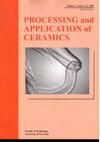Study of milling time impact on hydrogen desorption from LiAlH4-Fe2O3 composites
IF 0.8
4区 材料科学
Q3 MATERIALS SCIENCE, CERAMICS
引用次数: 0
Abstract
LiAlH4 was modified by mechanical milling and with the addition of 5 wt.% Fe2O3 in order to improve its hydrogen desorption properties. The composite was milled for 1, 3, 5, 7 or 15min, and depending on the milling time, various phenomena took place. Up to a milling time of 5min, the particle size of the composite decreases. Further milling leads to the particles agglomeration reaching the size of the starting material after 15min. Moreover, the mechanical milling process leads to the transformation of AlH - 4 to AlH 3 - 6 structure as a result of partial hydrogen desorption. Hydrogen desorption during the milling is the most pronounced in the sample milled for 15min, so this sample has only one hydrogen desorption peak in the temperature-programmed desorption measurements.Mechanical milling with the addition of Fe2O3 for up to 15min improves LiAlH4 hydrogen desorption properties as hydrogen desorption temperature and apparent activation energies decrease.铣削时间对LiAlH4-Fe2O3复合材料脱氢影响的研究
通过机械铣削和添加5 wt.% Fe2O3对LiAlH4进行改性,以改善其脱氢性能。复合材料的铣削时间分别为1、3、5、7或15min,不同的铣削时间会产生不同的现象。当磨矿时间为5min时,复合材料的粒度减小。进一步研磨,15min后颗粒团聚达到起始物料的大小。此外,机械铣削过程导致AlH - 4结构向AlH 3 - 6结构转变,这是由于部分氢的脱附。铣削过程中的氢解吸在铣削15min的样品中最为明显,因此该样品在温度编程解吸测量中只有一个氢解吸峰。机械铣削15min后,随着脱氢温度和表观活化能的降低,LiAlH4的脱氢性能得到改善。
本文章由计算机程序翻译,如有差异,请以英文原文为准。
求助全文
约1分钟内获得全文
求助全文
来源期刊

Processing and Application of Ceramics
MATERIALS SCIENCE, CERAMICS-
CiteScore
1.90
自引率
9.10%
发文量
14
审稿时长
10 weeks
期刊介绍:
Information not localized
 求助内容:
求助内容: 应助结果提醒方式:
应助结果提醒方式:


